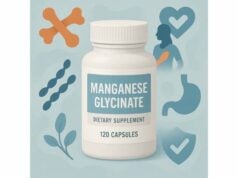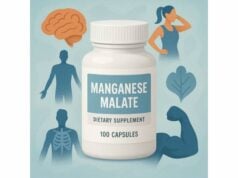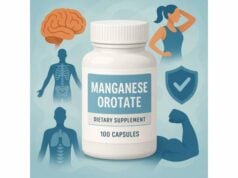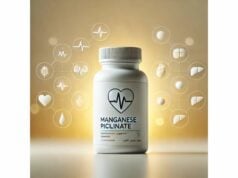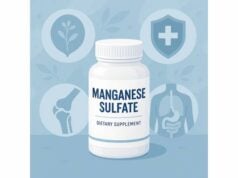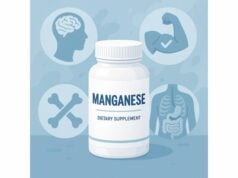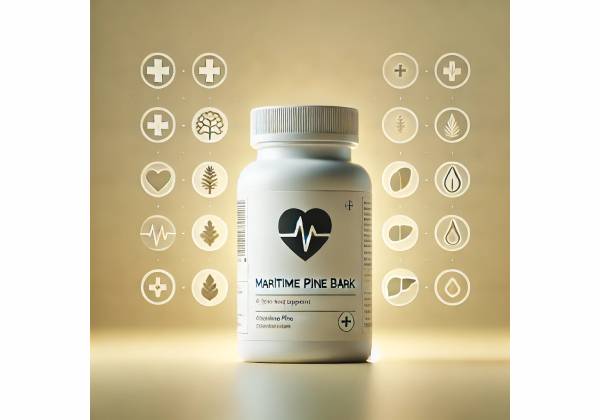
Maritime pine bark extract—best known by the standardized brand Pycnogenol—has become a go-to botanical for supporting circulation, healthy skin, and select cardiometabolic markers. Extracted from the bark of Pinus pinaster grown along the Atlantic coast of France, it is standardized for a family of polyphenols called procyanidins. These compounds show antioxidant, endothelial-supporting, and anti-inflammatory actions in human studies. People most often use maritime pine bark to help with mild blood pressure and glucose trends, leg heaviness from poor circulation, recovery from exercise, and skin elasticity. A practical plus: it is taken in capsules or tablets, with typical daily intakes ranging from 50 to 200 mg, and tends to be well tolerated. This guide explains what the extract is, where evidence is strongest (and where it is mixed), how to dose it for different goals, who should avoid it, and what to look for on labels so you are choosing a quality product—not a vague “pine complex” with unclear potency.
Key Insights
- Small but meaningful support for systolic and diastolic blood pressure and fasting glucose has been seen with 100–200 mg/day over 8–12 weeks.
- Circulatory benefits include reduced leg heaviness and improved microcirculation; some evidence suggests skin elasticity and photoprotection support.
- Typical dosage: 100–200 mg/day of standardized maritime pine bark extract (often labeled as Pycnogenol), taken with meals.
- Avoid or use caution with anticoagulants, antiplatelet drugs, and glucose- or blood pressure–lowering medicines without clinician oversight.
Table of Contents
- What is maritime pine bark?
- What benefits are realistic?
- How to use it day to day
- How much and when to take
- Side effects and who should avoid it
- What the research says today
What is maritime pine bark?
Maritime pine bark extract comes from the bark of Pinus pinaster Aiton, a coastal pine native to southwest France and surrounding regions. The bark is rich in polyphenols—especially oligomeric procyanidins (OPCs), catechin and epicatechin units, and phenolic acids—that act as antioxidants and appear to influence endothelial function and inflammation pathways. Modern extracts are standardized for total procyanidins, usually in the range of 65–75% for the most-studied product. That standardization matters because polyphenol content and profile drive both potency and consistency across lots.
You will see several names on labels. “Maritime pine bark extract” is the generic descriptor; Pycnogenol is a proprietary, heavily studied extract made from French maritime pine and manufactured to pharmacopoeial specifications. Other brand-standardized extracts exist (e.g., Oligopin, Flavangenol). While different brands share core actives, their exact procyanidin profiles, extraction solvents, and quality systems can vary. When your goal is to reproduce outcomes from trials, match the standardization as closely as possible—ideally choosing a product that declares procyanidin content and cites human research in comparable doses and durations.
How it works, in plain language:
- Antioxidant and anti-inflammatory actions. Procyanidins can neutralize reactive oxygen species and downshift pro-inflammatory signals (e.g., NF-κB), supporting vascular tone and tissue recovery from daily stressors.
- Endothelial function. Maritime pine bark supports nitric oxide biology, which helps small arteries and arterioles dilate appropriately. Better endothelial responsiveness underlies observed improvements in microcirculation and small reductions in resting blood pressure.
- Extracellular matrix support. In the skin and vessel wall, procyanidins appear to help preserve collagen and elastin from enzymatic breakdown and may nudge fibroblasts toward rebuilding, aligning with observed changes in elasticity and edema scores.
- Glucose and lipids. Studies report modest improvements in fasting glucose, HbA1c, and LDL cholesterol in mixed adult populations. Mechanisms likely include reduced oxidative stress, improved endothelial sensitivity, and peripheral glucose handling.
What it is not: a drug or a cure. Maritime pine bark offers incremental benefits that accrue over weeks, not a rapid, dramatic shift. It also does not replace foundational care: balanced diet, sleep, movement, and prescribed therapies if you have diagnosed conditions.
Label reading basics:
- Species: Pinus pinaster.
- Standardization: clearly stated procyanidin percentage (e.g., 65–75%).
- Dose per serving: 50–200 mg per day typical in human studies.
- Excipients: keep it simple; avoid unnecessary stimulants, laxatives, or megadoses of vitamins unless specifically intended.
- Testing: third-party quality certifications and batch-level contaminant testing are helpful.
When sourced and dosed properly, maritime pine bark is a versatile, food-adjacent botanical with measurable, small-to-moderate effects in vascular, metabolic, and skin endpoints.
What benefits are realistic?
Circulation and microvascular comfort. One of the most consistent real-world outcomes with maritime pine bark is the feeling of lighter legs and improved calf comfort during long standing or travel. In clinical settings, this corresponds to improved microcirculatory measures and reductions in ankle edema in people with chronic venous insufficiency. The mechanisms—enhanced endothelial responsiveness and capillary integrity—also tie into eye microcirculation, where early-stage diabetic retinal changes have shown functional improvements in small trials. For everyday users, expect subtle changes such as less evening ankle puffiness and better tolerance of long walks after several weeks.
Blood pressure and cardiometabolic markers. Meta-analyses pooling randomized trials report small reductions in systolic and diastolic blood pressure—typically on the order of 2–3 mmHg for each—along with modest improvements in fasting blood glucose, HbA1c, and LDL cholesterol. Those numbers may sound small, but even a 2 mmHg population-level drop in systolic pressure translates into meaningful cardiovascular risk reduction over time. In individuals, the benefit is usually easiest to detect when baseline blood pressure is at the high end of normal or mildly elevated, and when the supplement is combined with diet and physical activity changes.
Skin elasticity and photoprotection. Maritime pine bark contains procyanidins that interact with the skin’s extracellular matrix. Trials have observed improvements in elasticity and hydration and reductions in pigmentation intensity when people pair daily extract with rigorously applied sunscreen. Users often notice smoother texture and more even tone after 8–12 weeks, especially in drier seasons. Think of it as “inside-out” support that complements topical retinoids and UV protection.
Exercise and recovery. Because the extract supports blood flow and counters oxidative stress, it can help with post-exercise leg heaviness and perceived recovery. Some athletes use it during heavy training blocks or before long-haul flights to reduce ankle swelling. While not a performance enhancer, improved microcirculation can make longer sessions more comfortable.
Cognition and attention. Small studies have explored attention support in school-aged children and cognitive performance in adults under fatigue or high workload. Findings are encouraging but heterogeneous; if cognitive support is your primary goal, set expectations carefully and consider an 8–12 week trial before judging.
Respiratory and seasonal symptoms. Early research suggests potential benefits for upper airway comfort during pollen season and for specific inflammatory respiratory conditions. Results are variable and depend on baseline disease control, timing, and dose.
What not to expect:
- Maritime pine bark does not replace antihypertensive or diabetes medications.
- It is not a stand-alone treatment for chronic venous disease requiring compression or procedures.
- For skin, it will not substitute for sunscreen or prescription topicals—rather, it augments a strong topical routine.
If your goals include small yet meaningful improvements in cardiometabolic trends, lighter legs after long days, or more resilient skin, maritime pine bark is a reasonable, low-burden adjunct—especially when paired with diet, movement, sleep, and sun protection.
How to use it day to day
Pick a standardized product. Look for labels that name Pinus pinaster and declare procyanidin content. Proprietary extracts such as Pycnogenol specify 65–75% procyanidins and typically publish detailed analytical data. Products with “pine bark blend” and no standardization are harder to dose predictably. If you want to mirror study conditions, choose a brand that cites human research and matches the dose range used in trials.
Decide on your primary goal and match the routine.
- Blood pressure and glucose support: 100–200 mg/day, taken once or divided, for at least 8–12 weeks. Pair with a DASH- or Mediterranean-style diet and regular walking or strength training.
- Leg comfort and microcirculation: 150 mg/day is common. Combine with calf raises, walking breaks, and compression garments on travel days.
- Skin resilience: 50–150 mg/day, alongside daily broad-spectrum sunscreen and a gentle retinoid routine. Expect 8–12 weeks to see elasticity changes.
- Travel days: Take your usual dose and move every hour. Hydration, ankle circles, and compression socks help more than any pill alone.
Timing with meals. Maritime pine bark is typically taken with food to improve tolerance. If you take it once daily, morning with breakfast is a simple anchor. If you split the dose, morning and evening work well. There is no strong evidence that timing relative to exercise materially changes outcomes; choose a time that you can maintain.
Smart stacking (keep it minimal).
- With blood pressure goals: prioritize potassium-rich foods, magnesium from diet, and regular activity before adding multiple supplements.
- With skin goals: sunscreen, vitamin C–rich produce, and sleep are higher-yield; pine bark is the “polish,” not the foundation.
- With glucose goals: the basics—fiber, protein distribution, and walking after meals—make the biggest difference.
Consistency beats intensity. Build a check-in after 8–12 weeks. Track two or three concrete metrics—home blood pressure, step count, perceived leg heaviness, or skin hydration/elasticity scores if you have a device. If you see no effect despite good adherence, consider reallocating budget toward lifestyle upgrades that move the needle more.
Travel and storage. Capsules are stable at room temperature. Keep bottles closed, away from heat and sunlight. For trips, a small pill case works; if you use weekly pill organizers, label them so you remember this is your vascular-support supplement, not a multivitamin.
When in doubt, simplify. If your supplement lineup is busy, remove lower-yield items before adding maritime pine bark. Your body benefits more from a few well-chosen, evidence-aligned tools used consistently than a crowded shelf.
How much and when to take
Evidence-aligned daily ranges. Most clinical trials use 100–200 mg/day of standardized maritime pine bark extract for 8–12 weeks. Some protocols use 50 mg/day for skin outcomes or up to 250 mg/day for specific vascular endpoints. If you are new to the extract and want a clear test, start at 100–150 mg/day for two to three months, then reassess.
By goal (typical ranges):
- Blood pressure and cardiometabolic trends: 100–200 mg/day. Expect small average improvements, often detectable with consistent home monitoring.
- Microcirculation and leg comfort: 150 mg/day. Combine with movement and, when appropriate, compression.
- Skin elasticity and tone: 50–150 mg/day. Keep sunscreen and retinoids in place; think “augment,” not “replace.”
- Eye microcirculation (clinician-directed): 100–150 mg/day has been used in early-stage support settings. Coordinate with your ophthalmologist for suitability and follow-up.
Dose form and frequency. Capsules or tablets dominate the market. A common pattern is 50 mg per capsule; two or three capsules per day meet target intakes. You can take the full daily dose with breakfast or split morning/evening if you experience any stomach sensitivity.
Stacking and cofactors. There is no mandatory cofactor, but maritime pine bark fits naturally into a cardiometabolic routine with dietary potassium from plants, magnesium from nuts and legumes, and omega-3–rich fish. For skin, pair with topical sunscreen and retinoids; for leg comfort, stack with movement breaks and hydration.
How long until results. Vascular and metabolic changes are gradual: 8–12 weeks is a fair window to evaluate blood pressure trends, perceived leg heaviness, and fasting glucose. Skin outcomes typically require a similar timeframe for changes in elasticity or hydration metrics. If you stop, benefits fade over subsequent weeks as the body returns to baseline.
Upper limits and special cases. There is no formally established Tolerable Upper Intake Level. Human trials commonly top out at 200–250 mg/day for several months. Higher intakes do not necessarily mean bigger effects and may increase the chance of digestive upset. If you are on medication for blood pressure, glucose, or blood thinners, avoid dose escalation without clinician input.
How to evaluate your trial. Before starting, note three baseline points: average morning blood pressure across a week, perceived leg heaviness at day’s end (0–10 scale), and one concrete skin measure (hydration or texture photo under consistent lighting). Recheck at week 4 and week 12. If you are within your target and feel better, you can taper to the lowest dose that maintains benefits—many people land at 100 mg/day after an initial period at 150–200 mg/day.
What NOT to do. Do not swap this extract in place of prescribed therapy. Do not combine it with multiple new supplements so effects become impossible to attribute. Do not chase marginal gains with very high doses; maritime pine bark delivers modest benefits best captured with consistency, not megadosing.
Side effects and who should avoid it
Overall tolerability. Standardized maritime pine bark extract is generally well tolerated in healthy adults at 50–200 mg/day. The most common side effects are mild gastrointestinal symptoms (fullness, nausea) and occasional headache. Taking the supplement with food and splitting the dose can improve comfort. Skin rash is rare but possible; discontinue if a reaction occurs.
Blood pressure and glucose considerations. Because the extract can modestly lower blood pressure and fasting glucose, people on antihypertensive or glucose-lowering medications should monitor closely. Discuss your plan with a clinician if you take ACE inhibitors, ARBs, beta blockers, calcium channel blockers, insulin, or oral hypoglycemics. The goal is to avoid additive effects that push you below your safe ranges.
Bleeding and clotting. Maritime pine bark may influence platelet function. If you take anticoagulants or antiplatelet agents (e.g., warfarin, apixaban, clopidogrel, high-dose aspirin), or you have a bleeding disorder, consult your clinician before use. Stop the supplement at least one to two weeks before an elective surgery unless your surgeon advises otherwise.
Allergies and sensitivities. Avoid if you have a known hypersensitivity to pine-derived products. Individuals with multiple plant polyphenol sensitivities should patch-test cautiously under medical guidance.
Pregnancy and breastfeeding. Safety data are limited. Because pregnancy changes blood volume and vascular tone, and because polyphenols can have pharmacologic effects, avoid routine use unless your obstetric clinician explicitly approves.
Kidney and liver disease. There is no signal of direct harm in stable chronic disease at common doses, but any new supplement in the context of organ impairment warrants medical supervision. If your care plan includes protein or potassium restrictions, consider whether your broader diet—not the extract—needs first attention.
Drug and supplement interactions (practical list). Exercise caution and clinician oversight if you use:
- Anticoagulants/antiplatelets: potential additive effects on bleeding risk.
- Antihypertensives: small additive blood pressure reductions.
- Glucose-lowering agents: small additive glucose reductions.
- High-dose NSAIDs: watch for GI tolerance.
- Stimulants: no direct interaction is known, but avoid products that bundle stimulants with polyphenol-heavy extracts if you are sensitive.
When to stop and seek care. Stop immediately and seek evaluation for signs of allergic reaction (hives, swelling, breathing difficulty), unexplained bruising or bleeding, symptomatic hypotension (lightheadedness, fainting), or persistent GI distress.
Bottom line: with informed, monitored use, most adults can take maritime pine bark safely. Respect its subtle effects on blood pressure and glucose, and build your plan around your existing medications and health goals.
What the research says today
What’s strongest. Across randomized, placebo-controlled human trials, maritime pine bark shows consistent, modest benefits for vascular endpoints and cardiometabolic markers. Pooled analyses find small but statistically significant reductions in systolic and diastolic blood pressure, with the largest effects in trials lasting longer than 12 weeks and in combinations with standard care. Meta-analyses also report improvements in fasting glucose, HbA1c, and LDL cholesterol, positioning the extract as an adjunct for people working on metabolic health through diet and movement.
Microcirculation and eye health. In early retinal microangiopathy, trials have reported improved retinal blood flow, reduced edema, and better visual acuity compared with placebo. These outcomes align with the extract’s effects on small-vessel function and capillary integrity. For everyday circulation—leg heaviness, ankle swelling—clinical and user reports converge on gentle, noticeable improvements after weeks of use, especially in people who also elevate legs, walk regularly, and wear compression on long trips.
Skin and photoaging. Multiple studies show increases in skin elasticity and hydration, with some evidence for reduced pigmentation intensity when used alongside photoprotection. The proposed mechanism is preservation of collagen and elastin by reducing oxidative and enzymatic stress, plus endothelial support for nutrient delivery to the skin.
Mechanistic backbone. Pharmacokinetic work demonstrates that low-molecular-weight constituents and metabolites are absorbed and circulate at biologically relevant levels. In vitro and in vivo findings—antioxidant activity, modulation of nitric oxide pathways, and extracellular matrix enzyme regulation—map well to the clinical endpoints seen in humans.
Heterogeneity and limitations. Not all trials agree. Some meta-analyses detect no significant effect on certain endpoints (for example, specific blood pressure datasets or lipid fractions). Reasons include differences in extract brand and standardization, varying baseline risk of participants, short durations, and small sample sizes. Funding sources also vary; industry involvement is common, which underscores the need for independent replication.
Comparing brands. Pycnogenol is the most studied and tightly standardized extract. Other maritime pine bark products may be effective, but the evidence base is deeper for extracts with explicit standardization and published pharmacokinetics. When reading labels, match the species (Pinus pinaster), procyanidin percentage, and dose to reported trials to increase the odds of seeing comparable results.
How to interpret for your life. If you are targeting incremental, real-world improvements—a few points off blood pressure, a nudge to fasting glucose, lighter legs, or better skin feel—maritime pine bark is an evidence-aligned adjunct. Expect benefits after 8–12 weeks, maintain the basics (diet, activity, sleep, sun protection), and evaluate with concrete, trackable metrics. If you need larger changes, start with foundational lifestyle strategies and clinician-directed therapies; add pine bark as the finishing layer.
References
- Pycnogenol® French maritime pine bark extract in randomized, double-blind, placebo-controlled human clinical studies 2024 (Review of RCTs)
- Review of the pharmacokinetics of French maritime pine bark extract (Pycnogenol®) in humans 2024 (PK Review)
- Does supplementation with pine bark extract improve cardiometabolic risk factors? A systematic review and meta-analysis 2025 (Systematic Review and Meta-analysis)
- Effect of pycnogenol supplementation on blood pressure: A systematic review and meta-analysis of clinical trials 2020 (Systematic Review and Meta-analysis)
- Pycnogenol improves microcirculation, retinal edema, and visual acuity in early diabetic retinopathy 2009 (RCT)
Disclaimer
This article provides general educational information and is not a substitute for medical advice, diagnosis, or treatment. Always consult a qualified healthcare professional before starting any supplement, especially if you take prescription medications for blood pressure, blood thinning, or blood sugar control, are pregnant or breastfeeding, or have allergies. If you experience dizziness, unusual bruising or bleeding, rash, or persistent stomach upset, stop the supplement and seek medical care.
If this guide helped you, please consider sharing it on Facebook, X (formerly Twitter), or your favorite platform, and follow us for future evidence-informed health guides. Your support helps us continue producing high-quality, people-first content.

